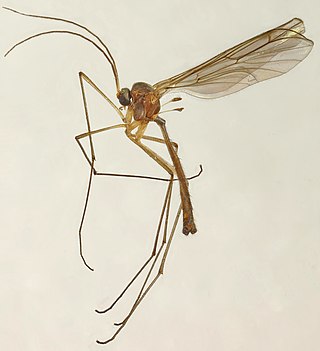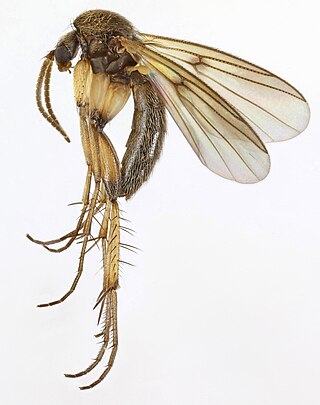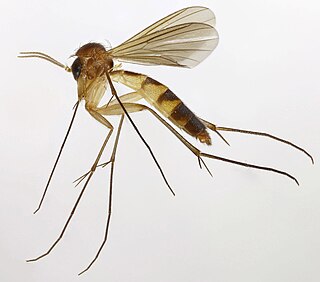Related Research Articles

The Nematocera are a suborder of elongated flies with thin, segmented antennae and mostly aquatic larvae. This group is paraphyletic and contains all flies except for species from suborder Brachycera, which includes more commonly known species such as the housefly or the common fruit fly. The equivalent clade to Nematocera is the whole Diptera, with Brachycera as a subclade. Families in Nematocera include mosquitoes, crane flies, gnats, black flies, and multiple families commonly known as midges. The Nematocera typically have fairly long, fine, finely-jointed antennae. In many species, such as most mosquitoes, the female antennae are more or less threadlike, but the males have spectacularly plumose antennae.

Mycetophilidae is a family of small flies, forming the bulk of those species known as fungus gnats. About 3000 described species are placed in 150 genera, but the true number of species is undoubtedly much higher. They are generally found in the damp habitats favoured by their host fungi and sometimes form dense swarms.

The Diadocidiidae are a family of flies (Diptera), containing one extant genus with over 20 species and one extinct genus. Diadocidiidae are found worldwide, except in Africa and Antarctica. They are usually considered close to the Keroplatidae, Bolitophilidae, and Ditomyiidae, and used to be included in the Mycetophilidae. They are woodland flies, found in shaded places in forests or near streams. The larvae spin silken tubes under bark or in dead logs, and feed on hymenium of Polyporaceae fungi. The average body length for adults is around 2.5–5.6 mm.

Bolitophila is the sole living genus in the Bolitophilidae, a family of Diptera in the superfamily Sciaroidea, with around 40 Palaearctic and about 20 Nearctic species, and three species from the Oriental region (Taiwan). They are small (6–9 mm).

The Ditomyiidae are a small family of flies (Diptera).They are found worldwide, most species are found in the Australasian and Neotropical realms. There are only two genera in Europe Ditomyia Winnertz, 1846 and Symmerus Walker, 1848 Ditomyia is found in Central Europe Symmerus in Northern Europe Symmerus is endemic to the Palaearctic.
Bradysia ismayi is a species of fungus gnat found in the British Isles.

Leptomorphus is a genus of fungus gnats in the family Mycetophilidae. There are about 8 described species in Leptomorphus.
Sciophilinae is a subfamily of fungus gnats. There are at least 40 genera and 340 described species in Sciophilinae.

Zygomyia is a genus of fungus gnats in the family Mycetophilidae. There are at least 80 described species in Zygomyia.

Symmerus is a genus of fungus gnats and gall midges in the family Ditomyiidae. There are about five described species in Symmerus.
Eudicrana is a genus of fungus gnats in the family Mycetophilidae. There are about 13 described species in Eudicrana.
Ectrepesthoneura is a genus of fungus gnats in the family Mycetophilidae. There are more than 20 described species in Ectrepesthoneura.
Probolaeus is a genus of long-beaked fungus gnats in the family Lygistorrhinidae.
Rhipidita is a genus of fungus gnats in the family Ditomyiidae.
Nervijuncta is a genus of fungus gnats in the family Ditomyiidae.
Australosymmerus is a genus of fungus gnats in the family Ditomyiidae.

Exechiopsis is a genus of fungus gnats in the family Mycetophilidae.

Allodiopsis is a genus of fungus gnats belonging to the family Mycetophilidae.

Acnemia is a genus of fly belonging to the family Mycetophilidae.

Sciophila fractinervis is a species of fungus gnat in the family Mycetophilidae.
References
- ↑ Lane, J. (1952). "Some new Brazilian Mycetophilidae (Diptera, Nematocera)". Dusenia. 3. Curitiba, Brazil: 131–140.
- 1 2 Freeman, P. (1951). "Mycetophilidae". Diptera of Patagonia and South Chile. 3. BM(HN): 138 pp., 49 pls.
- ↑ Curtis, J. (1937). British entomology. Vol. 14. London: Privately published. pp. 626–673.
- ↑ Chandler, P. J.; Bechev, D. N.; Caspers, N. (2006). "The fungus gnats (Diptera: Bolitophilidae, Diadocidiidae, Ditomyiidae, Keroplatidae and Mycetophilidae) of Greece, its islands and Cyprus". Studia dipterologica. 12: 255–314.
